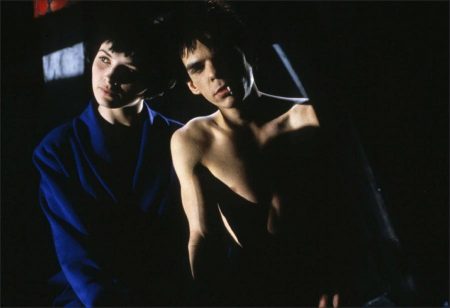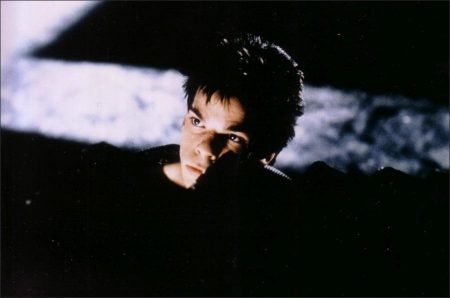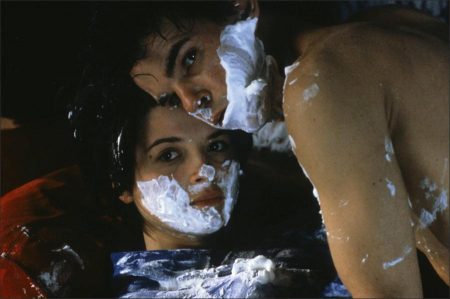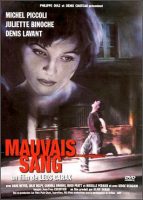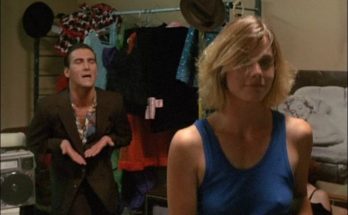Taglines: …love that burns fast but lasts forever…
Mauvais Sang movie storyline. Marc (Michel Piccoli) recruits Alex (Denis Lavant), son of his former, now dead colleague. Alex is a card shark with a big dream to go out to the world and leave his own mark. His determination leads him to break up with his girl friend, Lise (Julie Deply). Alex initially refuses to help Marc and Hans for their “job” of stealing the culture of new drug.
But Anna’s (Juliette Binoche) charm and beauty were irresistible. Alex joins the elders. Alex’s dance to David Bowie’s Modern Love illustrates unfolding emotions of young Alex moving into an adult (graying if not dying) world. The interplay among the generations, between genders, among social classes, memory and hopes, all played against black and white and occasional red back drop. Anna’s cobalt blue robe punctuates the moment when Alex confesses his love for her.
Mauvais Sang, also known as The Night Is Young, is Leos Carax’s second film. Released in 1986, the film played at the 37th Berlin International Film Festival before being nominated for 3 César Awards and winning the Prix Louis-Delluc. The film had 504,803 admissions in France. The title refers to the eponymous poem by Arthur Rimbaud in A Season in Hell.
Review for Mauvais Sang
Mauvais Sang saw Leos Carax thrillingly channeling some of the energy of his two greatest influences, the more intellectual Jean-Luc Godard and the more spiritual Robert Bresson. The enfant terrible, who once wrote film reviews under the editorship of Serge Daney at Cahiers du Cinéma, has always been something of a chameleon, and much like his close collaborator and on-screen alter ego, acrobat-turned-actor Denis Lavant, he possesses an impressive emotional agility that allows him to mimic different sensibilities. Carax and Lavant intuit and pantomime rather than reason and construct, and as such Mauvais Sang sometimes feels irrational and erratic, though never less than rapturous.
The story, a playfully Godardian toying with film-noir tropes, concerns a rebellious teen, Alex (Lavant), teaming up with his deceased father’s associates in Paris to steal a cure to an AIDS-like virus called STBO. Carax’s use of close-ups and elliptical montage tends to sideline the story in favor of more personal moments that also employ experimental touches to communicate an idea or a feeling, like the scene in which, through a zoom and sped-up camera, it appears as if Juliette Binoche is flying as she flaps her arms and runs down an airstrip.
Although Carax treats his story unseriously, it’s perhaps the lyrically depicted romance between Alex (Lavant) and his partner-in-crime’s (Michel Piccoli) girlfriend, Anna (Binoche), that he feels most strongly about. This is a film beyond story, one characterized by an infatuation with the medium itself: the edit, the close-up, the camera angle, movement, colors. Carax uses these tools to vivaciously celebrate cinema, as well as Lavant and Binoche (who he was romantically involved with), and his love for both is infectious. For the filmmaker, love is the reason for life: He even has the STBO virus explained to Alex as transmissible between people who have sex without love.
Carax frequently disrupts his simple narrative to pause on his two leads in moments seemingly out of time, scenes filled with beauty, uncertainty, and youthful faces. The most famous of these, referenced by Noah Baumbach in Frances Ha, is Lavant’s unforgettable dance through the street to David Bowie’s “Modern Love”; Carax films the sequence in one continuous side tracking shot, a welcome respite from the otherwise jagged sense of space that he creates through a mix of overhead, high-angle, and close-up shots.
The scene happens unexpectedly, yet it’s somehow emotionally relevant enough to Alex’s trapped, bubbling-up emotions that it feels like a natural progression for this young outsider, who’s just abandoned his girlfriend (Julie Delpy) at home to move to Paris, and a clear example of how Carax thinks fundamentally about cinema as non-verbal poetry and how he fashions his movies’ flow and tempo.
More than in his other films, Mauvais Sang is marked by Carax’s control of colors. He was improbably given a budget large enough to have sets constructed and Carax had his Paris streets designed to look unnaturally gray, if perhaps only to make the splashes of searing reds and bold blues stand out more.
While Lavant and his fellow burglars comically appear without shirts in several scenes because of a heat wave supposedly caused by Halley’s Comet, Binoche’s character is mostly seen dressed either in solid red or solid blue, with her lips naturally matching the film’s color scheme (she suggests a gentle, French version of a Patrick Nagel woman).
The emotional correlates of these colors obviously swing between passion and sorrow. But with some prominent whites are added to the mix, which can be seen on the film’s poster in the form of shaving cream on these young lovers’ faces, the obvious allusion is to the French flag, and in that sense the film echoes the way Godard used these colors to offer national commentary in his seminal film Two or Three Things I Know About Her.
Carax is more of a poet than a prose writer and the jumpiness of his vision is such that the film often reaches the senses before the mind, with its images speaking most immediately through its expressionistic flourishes. The easiest way to find entry into Mauvais Sang is simply to appreciate its jagged, colorful surfaces, its shimmering beauty and flashes of self-conscious lyricism, to accede to its reveries, even if they only temporarily make sense, and to welcome and possibly celebrate its shifting tones and techniques.
Mauvais Sang (1986)
Directed by: Leos Carax
Starring: Michel Piccoli, Juliette Binoche, Denis Lavant, Hans Meyer, Julie Delpy, Carroll Brooks, Hugo Pratt, Mireille Perrier
Screenplay by: Leos Carax
Production Design by: Jacques Dubus, Thomas Peckre, Michel Vandestien
Cinematography by: Jean-Yves Escoffier
Film Editing by: Nelly Quettier
Costume Design by: Dominique Gregogna, Martine Métert, Robert Nardone
Set Decoration by: Bernard Léonard
Distributed by: AAA Classics
Release Date: November 26, 1986
Visits: 116
